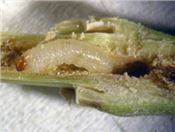Is The Corn Pith Weevil Making A Comeback?
DR. LEE TOWNSEND
LEXINGTON, KY.
Colby Guffey, Clinton County Ag & Natural Resources agent, sent digital pictures of larvae he found while investigating some unusual symptoms in silage corn. The larvae, which were tunneling in corn stalks, resembled European corn borers but were legless. In addition, their long tunnels were limited to the upper portion of the infested stalks. They were larvae of the corn pith weevil (figure 1 & 2), an insect first noted commonly infesting corn in Tennessee in 1911. The insect is not an economic pest.
G.G. Ainslie with the US Bureau of Entomology in Knoxville, reported on this insect at the 32nd annual meeting of the American Association of Economic Entomologists in 1920. Surveys reported the weevil from New York to Florida and westward to Iowa and Nebraska. Interest in the insect faded and there were few references to it until a report in the Bulletin of Pest Management and Crop Development in Illinois. The weevil was noted as being responsible for noticeable tip breakage in Bt and non-Bt corn hybrids in 2001. More recently, the pith weevil also was found by researchers examining stalks of Bt and non-Bt corn varieties for the European corn borer in areas of Pennsylvania (Bohnenblust et a. 2013). They found the insect to be more abundant in transgenic hybrids and in stalks that did not contain European corn borer larvae.
Life Cycle
The life cycle of the corn pith weevil takes one year. It spends the winter as a full-grown larva in a cell 3 inches to 4 inches below the soil surface. Adults (Figure 3) begin to emerge in early July and lay eggs in stalks immediately below the tassel during July and August. Late planted corn may have lower infestation rates. Barnyardgrass and other large grasses also may serve as hosts. The weevil larvae bore up and down in the pith, making larger cavities at nodes. When development is completed in early October, larvae leave the stalks through small elliptical holes and enter the soil.
Significance
Although tunnels of the corn pith weevil may cause tip breakage, there is no indication of economic damage. Without close examination, tunnels and larvae of the corn pith weevil can be mistaken for those of the European corn borer. This could lead to the erroneous conclusion that Bt hybrids were failing to provide control. Bohnenblust et al (2013) speculated that apparent increases in corn pith weevil activity may be related to their increased survival following mild winters and /or reduced competition from European corn borers. ∆
DR. LEE TOWNSEND: Extension Entomologist, University of Kentucky

Figure 1.

Figure 2.

Figure 3.